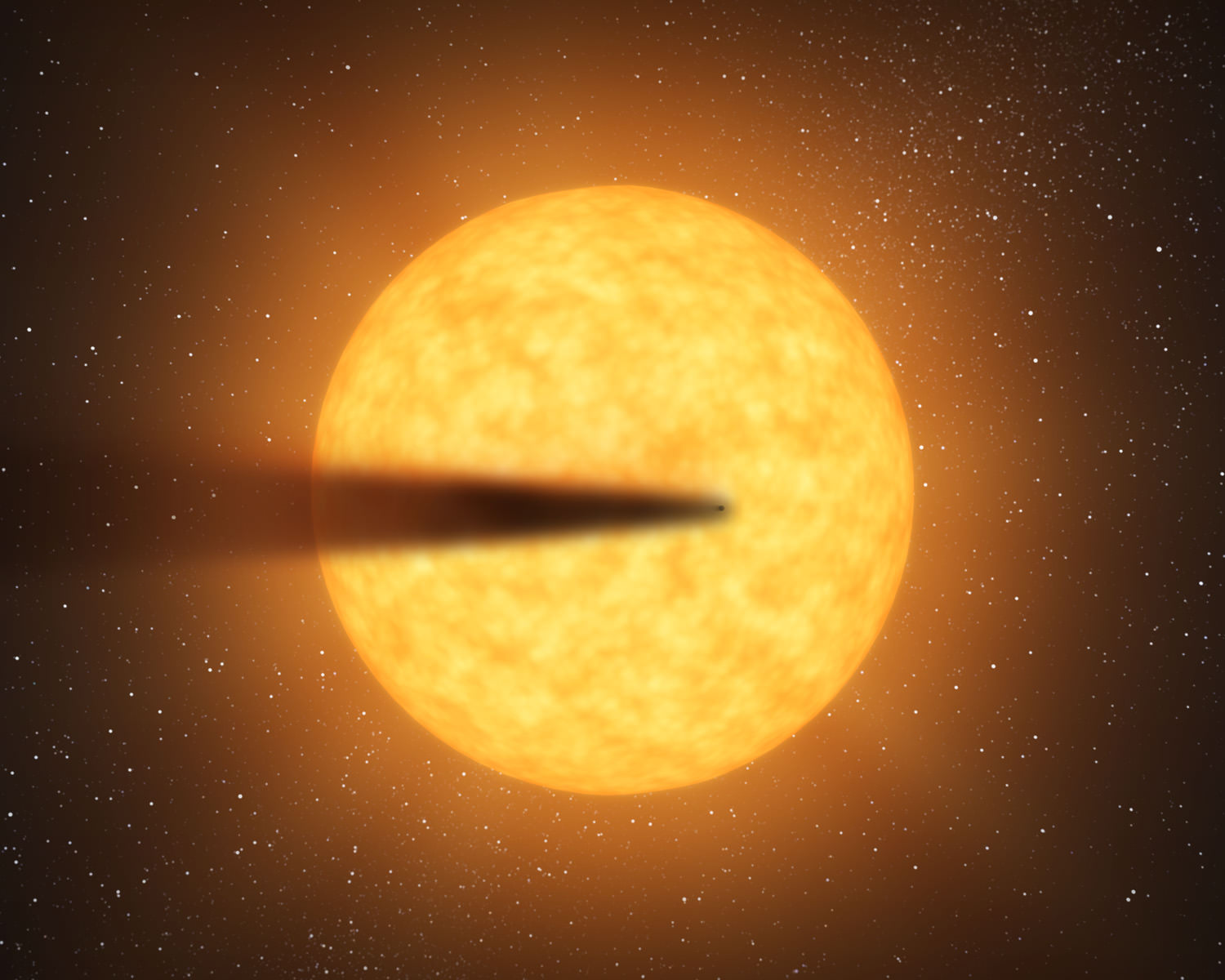[/caption]
The old saying of the universe being stranger than we can imagine definitely applies to a newfound exoplanet orbiting a star about 1,500 light years from Earth. Researchers using the Kepler space observatory have detected what appears to be a planet about the size of Mercury literally turning to dust. A long tail of debris — almost like a comet’s tail — is following the planet as it whirls around the star, KIC 12557548. Scientists think the planet could be evaporating under the blistering heat of the star, and that by analyzing the dust, they could decipher the history of the planet. But they better hurry. According to the team’s calculations, the planet will completely disintegrate within 100 million years.
“This might be another way in which planets are eventually doomed,” said Dan Fabrycky, a member of the Kepler Observatory science team.
Besides finding such an unusual planet, this is another leap forward for teams using Kepler data, being able to detect such a small planet orbiting so close to its parent star. The orbital period is 15 hours — one of the shortest planet orbits ever observed. The research team initially saw strange patterns of light from the star, and in examining the star’s light curves, they found the light dropped by different intensities every 15 hours — suggesting that something was blocking the star regularly, but by varying degrees.
The team considered that there might be a planetary duo — two planets orbiting each other — where their orbits would block out different amounts of light during each eclipse, but the data failed to support this hypothesis.
Instead, the researchers came up with a novel hypothesis: that the varying intensities of light were caused by a somewhat amorphous, shape-shifting body.
In looking at the short orbit, they realized the planet must be heated by its orange-hot parent star to a temperature of about 1,982 degrees Celsius (3,600 degrees Fahrenheit.)
Researchers hypothesize that rocky material at the surface of the planet melts and evaporates at such high temperatures, forming a wind that carries both gas and dust into space. Dense clouds of the dust trail the planet as it speeds around its star.
“It had to be something that was fundamentally changing,” said co-author Saul Rappaport, a professor emeritus of physics at MIT. “It was not a solid body, but rather, dust coming off the planet. We think this dust is made up of submicron-sized particles.”
Rappaport says there are two possible explanations for how the planetary dust might form: It might erupt as ash from surface volcanoes, or it could form from metals that are vaporized by high temperatures and then condense into dust. As for how much dust is spewed from the planet, the team showed that the planet could lose enough dust to explain the Kepler data. From their calculations, the researchers concluded that at such a rate, the planet will eventually completely disintegrate.
The researchers created a model of the planet orbiting its star, along with its long, trailing cloud of dust. The dust was densest immediately surrounding the planet, thinning out as it trailed away. The group simulated the star’s brightness as the planet and its dust cloud passed by, and found that the light patterns matched the irregular light curves taken from the Kepler Observatory.
“We’re actually now very happy about the asymmetry in the eclipse profile,” Rappaport says. “At first we didn’t understand this picture. But once we developed this theory, we realized this dust tail has to be here. If it’s not, this picture is wrong.”
“A lot of research has come to the conclusion that planets are not eternal objects,” said Fabrycky. “They can die extraordinary deaths, and this might be a case where the planet might evaporate entirely in the future.”
The group’s findings were published in the Astrophysical Journal.
Source: MIT


my buddy’s sister-in-law made $18108 a month ago. she worrks on the internet and bought a $525400 condo. All she did was get blessed and put into action the instructions given on this website ===>> ?????? http://hiringfreelancers.blogspot.com
my friend’s aunt made $17398 the previous week. she is making income on the internet and bought a $578000 house. All she did was get lucky and try the steps written on this website===>> ?????? http://hiringfreelancers.blogspot.com
I am constantly amazed by the kinds of science that Kepler can do! Honestly, I’m trying to come up with something similar but have to go to general observatories like Hubble or Spitzer for that.
Agreed. Quite wild and impressive.
Even more amazing to me is just what variety of worlds there is out there to be discovered – even fiction hasn’t ventured to imagine a planet like this!
Shouldn’t the dust tail oppose the star due to solar wind pressure?
I’m going to venture a guess here that it does. Curving out from the planet in a backwards arch such that it appears like the artist’s impression here. Seen from above the orbital axis, it would look like a comma after a big Zero in a sentence. { O, }